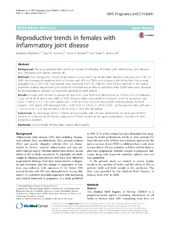Reproductive trends in females with inflammatory joint disease
Peer reviewed, Journal article
Published version

Åpne
Permanent lenke
https://hdl.handle.net/1956/12261Utgivelsesdato
2016-05-31Metadata
Vis full innførselSamlinger
Originalversjon
https://doi.org/10.1186/s12884-016-0919-7Sammendrag
Background: The study assessed birth trends per decade in offspring of females with inflammatory joint diseases (IJD) compared with women without IJD. Methods: This retrospective cohort study is based on data from the Medical Birth Registry of Norway from 1967 to 2009. We investigated singleton births in females with IJD (n = 7502) and compared with births from the general population (n = 2 437 110). Four periods were examined: 1967–79, 1980–89, 1990–99 and 2000–09. In the logistic regression analysis adjustments were made for maternal age at delivery and birth order. Odds ratios were obtained for the associations between IJD and birth outcome for each period. Results: Females with IJD had in average 65 deliveries / year (0.08 % of all births) in the 1970ies and 274 deliveries / year (0.5 % of all births) from 2000 to 2009. Adjusted Odds ratios (aOR) for newborns small for gestational age were 1.5 (95 % CI 1.2, 1.9) in the earliest and 1.1 (95 % CI 0.9, 1.2) in the last period. Correspondingly, for birth weight < 2500 grams aOR decreased from 1.4 (95 % CI 1.0, 1.9) to 1.1 (95 % CI 0.9, 1.4). For preterm birth aOR was 1. 1 (95 % CI 0.8, 1.5) in the first and 1.3 (95 % CI (1.1, 1.5) in the last period. Conclusion: An increasing number of births among females with IJD were observed in the study period. Birth weights of newborns of IJD women approached to birth weights in the general population, but preterm birth remained a problem.
